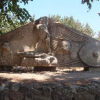
Side, which is 7 km away from Manavgat, is an ancient settlement center. Side, which is mentioned by historians as being founded in 1405 A.D., had been ruled by the Lydians, Persians, Alexander The Great, Antiogonous and Ptolemaioses respectively, beginning from the second half of VIth century A.D. After 215 A.D., the city, which had improved greatly under supervision of Syrian Kingdom, turned into a scientific and cultural center in the process. Having been left to the Bergama Kingdom as a result of the Apameian peace, the city later protected its independence along with the Eastern Pamphilya region. The city soon flourished, gaining tremendous wealth and prosperity with a huge commercial fleet.
It entered Byzantium rule after Roman rule after 78 B.C. Side, which was a Bishop center during Vth and VIth centuries, had lived its greatest times during these years.
The main gate of the city, which has a unique labor, lies between two towers. There are two main streets in the Side province. These streets are typical examples of the columned streets from the Ancient Age. After passing city gate, the flat stones adorned area is the starting point of this street. There are columned porticos beside both sides of these streets, and shops behind them.
There is a "Nymphaeum", the largest historical fountain of Anatolia, which is found against city gate, outside the ramparts. A wide pool place is below this foundation. You can reach a monumental structure by passing through a street after the theater. This building with dimensions of 100x100m, is an agora, in which lies the Bazaar area of the city. This area is surrounded by porticos and there are shops on three sides of it. There is a Gymnasium, surrounded by porticos and composed of three halls, on the street to the south side of the Agora. In the main street on the north to south direction, there is an arched structure, which was constructed during Roman Period. Importance of Side city's theater, in connection with architecture, is its construction on arched places instead of the slope of a hill like other roman theaters.
The theater, which is composed of three divisions: the cavea, orchestra and scene, is the biggest and most monumental one among the Pamphylia theaters, and has a capacity of 20.000 spectators.
There are wide cemeteries outside of Side's ramparts, with the most important one of these being the western necropolis, which is 1.5 km away. There are also temples and aqueducts in Side. The most important temples in the region are the Athena, Apollon and Men temples. The water of Side is brought from the Dumanlı source, within Oymapınar Dam Lake, approximately 25 km away. This water transportation system is composed of ten aqueducts, of which some are two layered. The biggest one is near to Oymapınar and has 40 specs.
A huge Roman Hamam was turned into a museum, and hosts the most beautiful archeological pieces of art from region. The city, which was reigned by Seljukians during the 13th century, Hamitoğulları and Tekelioğulları during the 14th century, and finally Ottoman Empire during the 15th century, was not a settlement area during this period.
Although most parts of the city ramparts, which possess the structure and characteristics of the Roman and Byzantium periods, have been demolished today.
 Side, which is 7 km away from Manavgat, is an ancient settlement center. Side, which is mentioned by historians as being founded in 1405 A.D., had been ruled by the Lydians, Persians, Alexander The Great, Antiogonous and Ptolemaioses respectively, beginning from the second half of VIth century A.D. After 215 A.D., the city, which had improved greatly under supervision of Syrian Kingdom, turned into a scientific and cultural center in the process. Having been left to the Bergama Kingdom as a result of the Apameian peace, the city later protected its independence along with the Eastern Pamphilya region. The city soon flourished, gaining tremendous wealth and prosperity with a huge commercial fleet.
Side, which is 7 km away from Manavgat, is an ancient settlement center. Side, which is mentioned by historians as being founded in 1405 A.D., had been ruled by the Lydians, Persians, Alexander The Great, Antiogonous and Ptolemaioses respectively, beginning from the second half of VIth century A.D. After 215 A.D., the city, which had improved greatly under supervision of Syrian Kingdom, turned into a scientific and cultural center in the process. Having been left to the Bergama Kingdom as a result of the Apameian peace, the city later protected its independence along with the Eastern Pamphilya region. The city soon flourished, gaining tremendous wealth and prosperity with a huge commercial fleet.